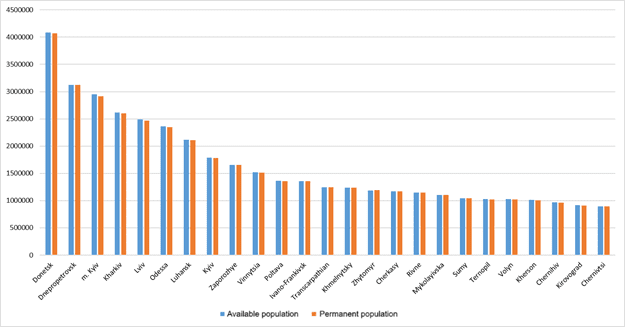
The US House of Representatives passed bill HR6930 on the allocation of assets subject to US sanctions for reconstruction and humanitarian assistance to Ukraine, the press service of the Congress reports.
“Specifically, within two years from the entry into force of this bill, the President (Joe Biden – IF) may seize such assets if (1) Russia continues to participate in the conflict of territorial seizures in Ukraine; (2) the President has imposed sanctions on the owner of the assets for reasons related to corruption, human rights violations, malicious influence or conflicts in Ukraine; and (3) the value of the assets exceeds $5 million,” the website says.
It is explained that “the seized assets can be liquidated and the funds received can only be used for certain purposes, including (1) post-conflict reconstruction of Ukraine, (2) humanitarian aid and refugee support for the Ukrainian people, (3) weapons for the Ukrainian armed forces ( …)”.
The law must be approved by the Senate and signed by the President of the United States to enter into force.
The House of Representatives of the US Congress passed a bill providing for the confiscation of Russian sanctioned assets.
According to Prime Minister of Ukraine Denys Shmyhal, he personally discussed the need for such an important step with Speaker of the House of Representatives Nancy Pelosi during a recent visit to the United States.
“Thank you for this fair decision. The aggressor must pay for the destroyed property! The provisions of the document allow these funds to be used to restore Ukraine, provide humanitarian assistance to Ukrainians and other assistance to the state, including military,” the head of the Ukrainian government said.
He added that Canada is currently preparing a similar bill, which he also spoke about with Canadian Deputy Prime Minister Chrystia Freeland during his visit to the United States.
ASSISTANCE UKRAINE, BILL, RUSSIAN ASSETS RESTORATION, US CONGRESS

Five Ukrainian scientific institutions and one university were included in the Global 2000 list of the Center for World University Rankings (CWUR), Minister of Education and Science Serhiy Shkarlet said.
“The Center for World University Rankings (CWUR) has released the list of institutions for 2022-2023. Almost 20 thousand institutions were included in the rating, and the best of them were included in the Global 2000 list. It is very pleasant that five powerful Ukrainian scientific institutions and one university were included in the list of the best in the world,” Shkarlet wrote in the Telegram channel.
It is noted that among them is the Kharkov Institute of Physics and Technology (1120), which was under fire from Russian invaders in March and bravely stood up, protecting Ukraine and the whole world from an environmental disaster.
Also included in the rating is the Institute of Scintillation Materials of the National Academy of Sciences of Ukraine (1898), whose scientists are actively involved in major international projects on high energy physics in the USA, Japan and Europe.
In addition, the rating includes the Institute for Nuclear Research (1709), the Institute of Cybernetics named after V.M. Glushkov (1740), Institute of Theoretical Physics named after N. N. Bogolyubov (1899) and Taras Shevchenko National University of Kyiv (1472).
“Despite the difficulties associated with military operations on the part of the Russian Federation, our teachers and scientists continue to work. We certainly have much to be proud of. We confidently prove that we are competitive in the international arena, and achievements in science make the state strong in all areas,” said Shkarlet.
Ukrainian population by regions as of Feb 1, 2022 (graphically)

SSC of Ukraine

Ukraine’s losses from destruction due to a full-scale war against Russia amount to at least $100 billion, the war has led to a complete shutdown of half of Ukrainian enterprises, Oleh Ustenko, adviser to the President of Ukraine, said.
As of March 7, the International Monetary Fund (IMF) predicted a fall in Ukraine’s GDP in 2022 as a result of Russia’s armed aggression, provided that it ends as soon as possible, by 10% and inflation rises to 20%.
The financial gap of Ukraine in 2022 is estimated from $4.8 billion according to the balance of payments method to $7.4 billion according to the fiscal balance method, such estimates were given by the International Monetary Fund (IMF) as of March 7 in materials for emergency financing for Ukraine in the amount of $1.4 billion posted on its website.
The International Monetary Fund (IMF) calculation methodology, which takes into account such military conflicts, estimates the fall in GDP due to Russia’s full-scale war against Ukraine at 35% in 2022, Alternate Executive Director for Ukraine at the IMF Vladislav Rashkovan has said.
The Ukrainian economy is suffering greatly from the war unleashed by Russia, the decline in its GDP could be a third of what it was before the war, International Monetary Fund (IMF) Managing Director Kristalina Georgieva said in a Foreign Policy Live discussion.
The Ministry of Economy estimates the amount of losses from the Russian invasion of Ukraine at $564.9 billion, First Deputy Prime Minister and Economy Minister Yulia Svyrydenko has said.
The fall in Ukraine’s gross domestic product (GDP) as a result of full-scale Russian military aggression is currently estimated at 35% or more, Prime Minister Denys Shmyhal said in an interview with Interfax-Ukraine.
Ukraine’s losses from Russia’s full-scale military aggression, taking into account both the destruction already inflicted on the infrastructure and economy, and future losses in subsequent years, exceed $1 trillion, Prime Minister Denys Shmyhal said.
The state budget in January-February 2022 had a surplus in the amount of UAH 24 billion, including a surplus of UAH 13.1 billion for the general fund, with a planned deficit of the general fund for this period of UAH 66.2 billion, the Ministry of Finance reported on its website.
The deficit of Ukraine’s foreign trade balance decreased by only 0.2% in 2021 compared to 2020, from $0.678 billion to $0.676 billion. According to it, over the past year, exports of goods and services increased by 34.3%, to $79.724 billion, while imports – by 33.9%, to $80.401 billion.
Ukrainian transport companies carried almost 2.657 billion passengers in 2021, which is 3.4% more than in 2020.
The transport enterprises of Ukraine (excluding the territory of the Autonomous Republic of Crimea and Sevastopol, as well as part of the JFO zone) in 2021 increased transportation of goods by 3.3% compared to 2020 – up to 619.9 million tonnes, the State Statistics Service reported.
In January 2022, retail trade turnover in Ukraine increased by 18% compared to the same month in 2021 in comparable prices, while in December 2021 the growth was 5.1%.
Production of grains and oilseeds in 2022 in Ukraine is preliminary estimated at 53.3 million tonnes, which is 51% lower than the previous season’s record, due to the Russian military invasion and ongoing hostilities, this year’s harvest may be minimum for the last 10-15 years.
Economic Monitoring’s Project Manager – PhD in Economics, Maksim Urakin

Swiss authorities are imposing a ban on coal imports from Russia following a similar decision by the European Union, the Swiss Federal Council said in a statement.
“The new measures include far-reaching sanctions on goods, including a ban on imports of lignite and coal as well as on goods that are important sources of revenue for Russia (e.g. timber, cement, seafood, caviar),” the statement said.
“In addition, there are export bans on goods that can help strengthen Russia’s industrial capacities (e.g. industrial robots or certain chemical products),” the document said.
BANS, COAL, IMPORTS, RUSSIA, SWITZERLAND